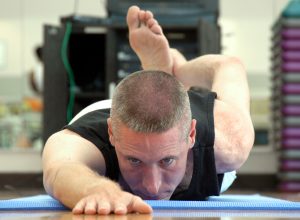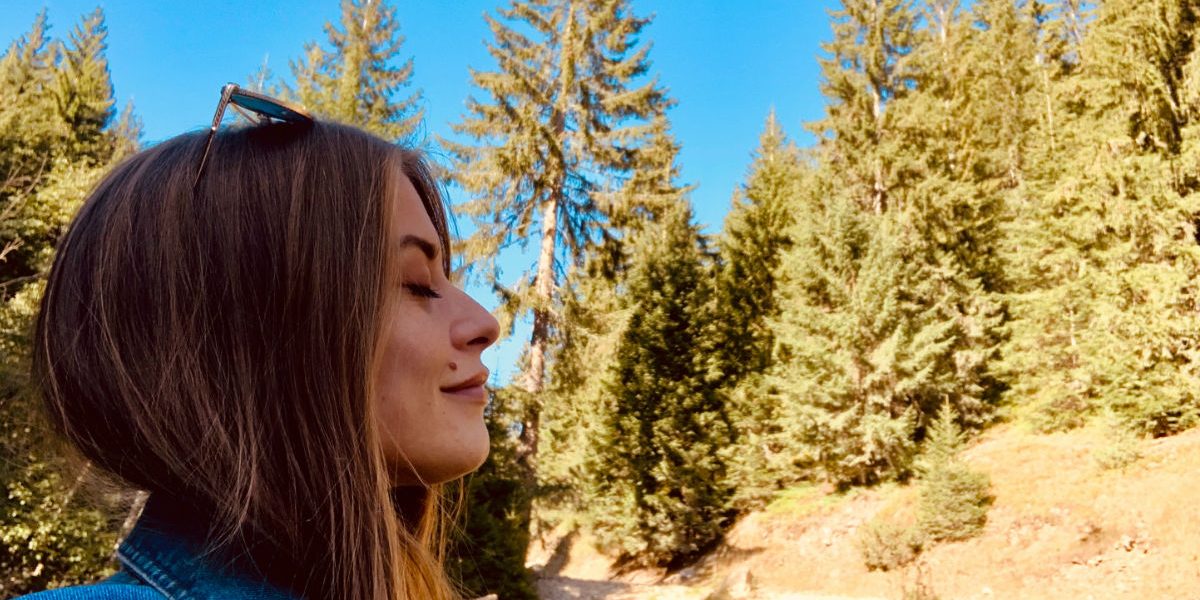You might be asking yourself why you’re reading this post about breathing.
We breathe in, we breathe out, hands up, now hands down, (back up, back up), tell me watcha gonna do now.
*Ahem*
In and out. It’s that simple, right?
Yes and no.
Breathing happens automatically.
When we’re babies, we breathe through our diaphragm. This is natural for us.
As we get older, though, we generally breathe through the chest. We forget how to do deep breathing, and that means it’s easy to forget how to breathe properly throughout our day, and especially during exercise.
In this article, I’m going to explain why breathing is the foundation of exercise and of life, and how to get the most of out of your DDPY workout with proper breath.
Why Breathing Is Important
To be blunt, you need to breathe in order to live.
You can survive without water for around a week, and you can survive without food for several weeks.
You can only survive without air, however, for a few minutes. Even trained divers can only hold their breath for an average of about five minutes.
That means that breathing is the key to life.
More specifically, breathing fuels your muscles.
The Physiological Purpose Of Breathing
Breathing consists of two parts: the inhale and the exhale.

When you inhale, your trachea carries air to your lungs. Muscles in your torso raise up and outward as your lungs expand and pull air in. Finally, your diaphragm contracts and pulls downward.
This inhaled air brings oxygen into the blood, which is first delivered to the heart before being transported to the rest of your body.
When you exhale, the reverse happens. Your diaphragm relaxes and springs upward. Your lungs shrink as they push air out. Your torso muscles relax as your ribcage moves downward and forward. Your lungs shrink as they expel air through your nostrils or your lips.
The exhaled air is rich in carbon dioxide, a waste product. Too much CO2 in your body can lead to respiratory failure.
In short, inhaling fuels your body, while exhaling eliminates waste.
Why Breathing Is Significant In Yoga
The term “yoga” is Sanskrit for “union,” the integration of mind and body disciplines.
Pranayama, another Sanskrit term, is “the practice of voluntary breath control, consisting of conscious inhalation, retention, and exhalation,” according to the American Council on Exercise Personal Trainer Manual.
Pranayama could be coupled with a posture, or “asana,” to prepare an individual for practicing breath control and meditation. Practitioners used these asanas to acquire spiritual freedom and meditative states.
Physiologically, ACE says yogic breathing has been found to create a “mind-body” pathway between muscles and the brain, “affording direct access of muscular activity to the mechanisms of perception and cognition”.
In other words, according to ACE, breathing is an intermediary between the body and the mind.
“The fundamental purpose of breath work is to develop the ability to:
(a) sustain relaxed attention to the flow of the breath,
(b) refine and control respiratory movements, and
(c) integrate awareness and breathing to reduce stress and enhance psychological functioning”
The Medical Benefits Of Proper Breathing
In my research for this article, I found literally dozens of benefits of mind-body exercise and, specifically, yogic breathing.
For this article, I’ll look at three benefits: blood-pressure reduction, stress reduction, and increased blood flow.
Yogic Breathing Can Reduce Systolic Blood Pressure
Using a 2:1 breathing pattern, people with high blood pressure can decrease it.
From ACE:
“Adhana (2013) found that, in patients with hypertension, exhaling twice the time of inhalation caused a response similar to those patients taking one or two blood pressure medications.”
That’s a stunning finding.
Simply by altering our breathing pattern, we can cut out blood pressure medication. We can save money and prevent side effects by doing something our body does naturally for free.
ACE warns, however, that people with cardiovascular or pulmonary disease should focus on standard breath work and not progress to advanced techniques, such as rapid breathing, breath retention (pausing after inhaling), or breath suspension (pausing after exhaling). These techniques are mentioned later in this post.
Yogic Breathing Reduces Stress
In Yoga for Regular Guys, Dallas and the Yoga Doc mention another benefit of yogic breathing: it helps reduce stress.

Long, slow breaths decrease the “fight or flight” feeling, a segment of the sympathetic nervous system that is activated by the perceived threat of danger, such as a thug or an angry dog.
Physiologically, “fight or flight” manifests as an increased heart rate, resulting in quicker breathing, as well as tense muscles and sweating. According to Harvard Health Publications:
“The carefully orchestrated yet near-instantaneous sequence of hormonal changes and physiological responses helps someone to fight the threat off or flee to safety. Unfortunately, the body can also overreact to stressors that are not life-threatening, such as traffic jams, work pressure, and family difficulties.”
The Harvard link also mentions a study in which relaxation techniques (which included yoga and deep abdominal breathing) helped wean participants off blood pressure medication, supporting the study referenced by ACE in the previous section.
Yogic Breathing Increases Blood Flow
Dallas and the Yoga Doc say in their DDP Yoga certification manual that people get sore when they work out for the first time (or after a period of inactivity) because blood oxygen levels are low, and your body doesn’t get the oxygen it needs.
Accelerating your heart rate brings a 25% increase in blood flow through vertebral and internal carotid arteries, according to a study referenced in the DDP Yoga Level 1 manual (that I couldn’t track down in the October 2007 issue of the Journal of Applied Psychology). This means that your blood vessel diameter increases and is sustained during exercise.
The Importance of Breathing in DDP Yoga
Proper breathing during your DDP Yoga workout will help you sink deeper into your positions so that you can increase flexibility and your heart rate.
You’ll also be able to acquire mental and physical focus, endurance, balance, flexibility, and power.
“If you try to consciously fill your entire body with oxygen each time I ask you to inhale,” writes Dallas, “you will break up the tension that lives in the different corners of your body. You will get even greater benefits if you try to ‘push’ each inhalation into those tight spots.”
Breathing in this manner also increases your heart rate to get into your fat-burning zone, a topic I’ve covered previously.
Focus on each breath you take in class. It is challenging, but it is worth it.
How To Breathe In DDPY
The key to breathing in DDP Yoga, and in general, is your belly.
Just like when we were babies.
This is called diaphragmatic breathing, or deep abdominal breathing.
The goal is to fill your abdomen up like it’s a balloon.
Both the DDP Yoga system and ACE recommend similar ways to achieve this goal (each with their own unique personality), and I’ll explain them both.
The DDP Yoga Way
- Lay on your back.
- Bend your knees.
- Put both hands on your belly.
- Inhale for a count of 3, expanding your belly like Santa Claus.
- Exhale for a count of 3, pushing your belly button to the back of your spine.
- Repeat.
If you’d like, you can use counts of 5, 10, or whatever number you like. A greater number means greater breath control.
The ACE Way
- Lay on your back. Place a blanket or pillow underneath your head.
- Place one hand on your abdomen and one hand on your chest.
- Take 10-15 slow, deep breaths.
- Expand your abdomen during inhalation. Pause for a few counts after you finish your inhale.
- Contract your abdomen during exhalation. Pause for a few counts after you finish your exhale.
- Keep your chest as still as possible.
Each method varies just a bit, but I think you’ll see the similarities.
When we do this deep breathing, we see a host of benefits (in addition to the ones listed above):
- We create space between each vertebra, which helps heal compressed spinal discs.
- We squeeze trapped blood out of our organs, eliminating waste.
- We bring fresh, oxygenated blood back to our organs.
- We fix our posture and break up scar tissue caused by slouching, sitting, or driving for extended periods.
When To Breathe During DDPY

ACE recommends a warm-up of 3-5 minutes of quiet contemplation or meditation before low-level aerobic activity or flexibility exercise. They also recommend ending those workouts with a similar breathing cool-down.
You’ll notice a similar model in DDP Yoga. Classes typically begin and end with a breathing focus, and your certified instructor will be able to guide you through it.
Your DDP Yoga instructor is also trained on how to cue you for breathing during the workout. If he or she forgets, though, Yoga Journal has some better breathing tips that inspired this short list of how to breathe during DDP Yoga workouts and the DDPY Diamond Dozen:
Exhale when bending forward
- “Hulk it up!” on Diamond Cutter
- Catcher
- Cat Arch
- Down Dog
- Butterfly
- Broken Table Crunches
- Extended Side Angle
- Human Cannonball
Inhale when lifting or opening the chest
- Ignition
- Diamond Cutter
- Superstar
- Cat Lift
- Cobra
- Thunderbolt
- Road Warrior 1
- Bent-legged Bar Back (or Stiff-legged Bar Back)
- 3-legged Dog
- Broken Table
- Bridge
Exhale when twisting
- Road Warrior 2
- Twisting Lunge
- Twisting Triangle
Again, there are a number of other breathing cues throughout the DDP Yoga workouts on the DVDs and in person with your instructor, so pay attention to them.
Try It Out
As we’ve learned, breathing is essential. Breathing should be an active – not a passive – part of our everyday life.
We should look to babies as models for how to breathe so that we get full breaths each time.
Proper breathing assists you with getting a great workout, and provides a number of physiological and mental functions, as well.
On your next DDP Yoga workout, concentrate on your breathing. See how it affects your activity during your workout.
Maybe you’ll find you get more out of it.
Interested In A DDPY Class?
I teach DDPY. Check out my latest class offerings to find out how you can get involved!
Photo by Rebellé Fleur on Unsplash

3 Comments
Comments are closed.